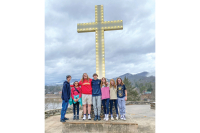Through his eyes
 Pulling into his steep, gravel driveway, the first thing you notice about Gary Montanari are his numerous pets.
Pulling into his steep, gravel driveway, the first thing you notice about Gary Montanari are his numerous pets.
“I hope you like dogs,” he said, as several barks are heard from around the property.
The second thing you notice about Gary Montanari is that he has lived an extraordinary life.
“I got to do a lot of neat shit,” the 65-year-old modestly stated with a laugh.
At his log cabin, perched atop a ridge between Dillsboro and Franklin, Montanari sits on a couch and relaxes into the cushions. It’s a comfortable moment for a man who has lived through his share of tense situations as a photojournalist roaming the globe in search of front-page images.
Related Items
He captured a young Muhammad Ali warming up in a gym, six Super Bowls, the first NASA space shuttle launch (Columbia), Diana Nyad’s legendary long distance swim and Doug Flutie’s iconic Hail Mary-touchdown throw. He has also been on the frontlines of wars, drug trades, and seemingly everything in between. His work has appeared in publications like National Geographic, Sports Illustrated, The New York Times and The Washington Post. Montanari has been a witness to history, his camera always in-hand.
“I did it in the glory days, and I’m glad I did it,” he said. “We were so fortunate back then to be able to do what we did. There are very few holes left to fill now in photography — I know what a buggy whip salesman went through.”
Start Your Engines
Born and raised in Brevard, Montanari and his family relocated to Miami in the early 1950s. He was just a kid then, and soon a love of racing grabbed hold of him. Motorsports were a rapidly growing spectator sport at that time, and Montanari was right in the center of the action, attending weekly races at Hialeah Speedway and Sebring Raceway.
Soon, Montanari got a job as a part of the safety crew at one of the tracks. When a part or piece of debris fell off one of the cars, these workers would sprint onto the track and grab the object before the cars rocketed around again. It was a dangerous job, but Montanari wanted to be as close to the action as possible.
On a chance encounter, a new worker came to apprentice with Montanari. The guy was fresh out of the military and wanted to know everything there was to know about racing. Montanari found out he was a photographer and suggested he be taught how to take a photo in exchange for the track knowledge.
“That’s how I became a photographer,” Montanari said. “I was going to the track and not really making much money. That guy didn’t know anything about motor racing, but did know photography. We apprenticed each other, and it soon became a career for me.”
While studying English at LaGrange College in Western Georgia, Montanari spent every free moment out of the classroom heading from tracks near and far, always eager to capture “the shot.” He was freelancing then, taking pictures of competitions, racers and their cars, and selling them the shots for money to get by.
“I got my foot in the door. I got to go to the racetrack and I was getting paid, and I got to see all of the racecars,” he smiled.
After graduation, Montanari sold his car and headed for Europe to photograph Formula One races, which included the prestigious Monaco Grand Prix. He remembers vividly, and fondly, interviewing and photographing Graham Hill. Dubbed the “King of Monaco,” Hill is the only driver to win the Triple Crown of Motorsport — the 24 Hours of Le Mans, Indianapolis 500 and Formula One World Championship.
“I was a young kid then, probably not even shaving,” Montanari chuckled. “And here I was, on this balcony in Spain, with Graham Hill.”
Onward To Magic City
Coming back to Miami, Montanari landed a photographer gig in Hialeah at a small newspaper called The Home News. He covered local events and spot news, mainly the police beat. That position led to an opening at the Miami Daily News and stringer work at the United Press International. Though the work was chaotic and often gruesome, due to the violent cocaine trade in the city during the late 1970s and 1980s, Montanari was once again in the middle of the action of the era.
“Miami was getting pretty crazy then, and it was so out of control you wouldn’t understand it,” he said. “Crime, conventions, hurricanes — all of it. We had so many homicides that we’d only go cover them if there were multiple victims.”
In the heat of the cocaine trade, Montanari was sent to cover a drug dealer killing. Escorted by the police, he stepped foot into an empty apartment. All the space contained was a small folding card table and a dead man with his thumbs tied behind his back, a bullet in the back of his head. On the table was a pile of cocaine the size of a grapefruit and $80,000 in cash next to it.
“It was so crazy that there was so much product on the streets where the [assassins] didn’t need that pile or the cash, especially since the police could trace the money if it was deposited in the bank,” he said.
In 1979, Montanari was the support diver for Diana Nyad when she swam 28 miles from North Bimini in the Bahamas to Juno Beach, Fla. He was the only photographer onsite, with those images being used by Sports Illustrated.
“I was in that water for 29 hours,” he shook his head with a groan.
He was also in a water tank for 36 hours with a pregnant manatee at the Miami Seaquarium. Montanari was friends with Jesse White, a renowned veterinarian, who was the first person to successfully breed a manatee in captivity. Those photos ended up in National Geographic.
Then there were the other moments. Like being in the end zone during the “Hail Flutie” in 1984, where Boston College quarterback Doug Flutie threw up a 63-yard pass with time expiring for a touchdown to defeat the defending national champion University of Miami. It is regarded as one of the most memorable moments in sports history. Montanari was just mere feet away from BC’s catch.
“Right place at the right time,” he said. “Nobody knew he was going to make that pass, but he did. And I got the shot of them going upward.”
But then there were the moments of terror, where his life was in jeopardy. In 1979, the Sandinista National Liberation Front overthrew Nicaraguan dictator Anastasio Somoza DeBayle. Montanari was in Nicaragua covering the murderous coup when suddenly he was held hostage in his hotel. It was in that moment he realized how dangerous his profession could really be.
“I thought I was going to die, brother,” he said through solemn eyes.
Back To The Smokies
Montanari retired in 2005. Following his photography career, he worked in television news for a period as an assignment editor. The world was beginning to change, news was beginning to change, and Montanari was seeing the writing on the wall. With a no-country-for-old-men sentiment floating through newsrooms around the world, journalism had shifted. Photographers and writers alike were being cut left and right, with the soul of the industry disappearing with every newspaper closure and media consolidation.
“No, I couldn’t do it now. Journalism has changed, buddy. They’re firing all the reporters and giving all the photographers pencils,” he said. “And I’m not technically savvy. I don’t know how to use a digital camera. I was a newspaper photographer — I didn’t even take that many photos of my kids.”
When asked if he looked at his work as art, he scoffs at the thought.
“It’s not an art for me. I never considered myself an artist,” he said. “It’s a craft, a tool — I’m capturing history.”
Montanari’s dogs bounce on and off of him in a round-robin stream of fur and barking. Relaxing further into his couch cushions, Montanari reels off innumerable names like listings in a phone book. Each name was a friend, each name a story. Some have died. Several are still photographing. But each was lucky enough to cross paths with Montanari, and vice versa. He remembers all of them, many-a-time with a slight pause and look upward before diving into another story.
“I think in my entire career I may have called in sick twice,” he said. “I hope people find jobs that they really like. You’ve got to care about people, and you’ve got to do your job — it was a great life.”









